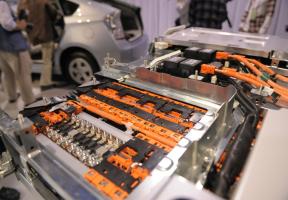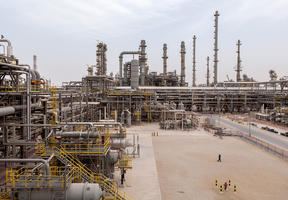The Future of the Automobile
10 min read

Guillaume Devauchelle
Tomorrow’s Vehicles Are Being Designed Today
In the early 20th century, transportation experienced a revolution as the horse-drawn carriage was replaced by the automobile within a period of 15 years. Today, one hundred years later, we are witnessing an even greater disruption.
At a time when the world’s population is becoming increasingly concentrated in urban areas, transportation needs to address the three major requirements of greener, safer and more connected mobility. For the global auto industry, this means tackling three key technological challenges at the same time: the development of electric powertrains to curtail CO2 emissions, driver assistance systems to enhance vehicle safety and autonomy, and digital solutions to provide new services and modes of transportation.
The transformation of the car industry has already begun, without our necessarily having realized it. The future of the car is being shaped right before our eyes, day after day. To illustrate this point, since 2004, no more than two years have gone by without our having introduced unprecedented new products in the area of driver assistance alone. We developed a number of world firsts, starting with a lane departure warning system and followed by a fully automatic parking function and an image-processing solution that enables drivers to see behind their trailer or caravan, as if it were invisible.
The Convergence of Three Revolutions
The auto industry is therefore undergoing three separate revolutions. In reality, however, the three technologies combine, interact and intersect with each other to produce effective, groundbreaking innovation. A few real-life examples help illustrate this fact.
Driver assistance systems – no matter how smart – are only one of the factors behind the development of autonomous vehicles. Another factor is electric propulsion, which offers a high degree of technical simplicity. An electric motor eliminates the need for a gearbox, for example. Vehicle electrification concerns more than the powertrain. When batteries are used to power a car, their operating temperature needs to be controlled in order to preserve their lifespan and maximize range. Passenger comfort is another issue. The challenge is a complex one demanding the development of HVAC technologies for vehicles that are no longer equipped with an internal combustion engine. These examples show how the electric revolution is fueling transformations in unexpected areas.
No Global Standard but a Number of Regional Varieties
The advent of the autonomous car is redefining the onboard experience. Using biosensors and infrared cameras to monitor what the temperature feels like for each passenger, we have developed a system that offers a thermal comfort bubble adapted to all vehicle users’ needs, based on their heart rate, morphology and clothing. The onboard environment can also be adjusted to take into account the occupants’ emotional state or degree of tiredness. In addition, the interior lighting system uses color to create sensations, with warm shades for warmth and soft shades for coolness.
Drawing on artificial intelligence, we have developed new technologies that enable cars to recognize user habits and tastes. For example, the car automatically suggests personalized routes based on the driver’s schedule and routine. It compiles playlists aligned with driver and passenger preferences. And it reproduces the motorist’s driving style. Autonomous cars won’t have the same driving characteristics in Paris, London or Stuttgart, let alone Shanghai or Mumbai. Rather than a single global standard, there will be a host of autonomous vehicles adapted to the practices and customs of each locality.
The automobile revolution also raises the question of energy efficiency. In all likelihood, we will see a combination of different energy sources: gasoline, , , natural gas, and all manner of hybrids. Here too, we are heading toward a variety of solutions. If you live on Reunion Island, it might make sense to power your car using ethanol derived from sugar cane waste, but this wouldn’t necessarily be the best solution for metropolitan France.
Thanks to their smoother driving cycle, autonomous cars will reduce traffic jams and thereby save energy. For example, if cars are all connected and synchronized with the traffic lights, they will all start up at the same time when the light turns green, like a train.
And let’s not forget the indirect benefits. Did you know that the rearview mirror is one of the items that consumes the most energy? That’s because it only works if the rear window is flat. With the installation of a camera that lets drivers see what’s going on behind the vehicle, it will be possible to use more aerodynamic bodies, which would considerably lower energy consumption.

Bernard Jullien
The Future of Global Auto Markets
The history of the automobile is marked by the complex relationship between automakers competing for a share of world markets, on the one hand, and tax and environmental authorities responsible for establishing standards and regulations for cars and fuels, on the other. This “complicity”, which is dictated by the reality of the situation, has been reinforced by stepped-up international efforts to fight . Road transportation, which is responsible for nearly 20% of total CO2 emissions, is an extremely sensitive industry with a high level of government intervention.
A Mixed Automotive Landscape
China and Europe have adopted clear “anti-internal combustion engine” positions. In 2015-2016, the Chinese government decided to pursue an electrification strategy focused on the battery electric vehicle (BEV), as opposed to the plug-in hybrid electric vehicle (PHEV). It also set ambitious, steadily rising targets for sales of “new energy vehicles”: 10% of total annual vehicle sales in 2019, 12% in 2020 and 20% in 2025. These are realistic objectives, considering the level of authority wielded by the central government and the sheer size of the Chinese market. Electric two-wheelers benefit from the same support.
Europe has adopted a similar strategy, although it took a little more time to implement it. The European Union has agreed to curb CO2 emissions from passenger cars by 37.5% by 2030. This means that an estimated one-third of all new cars will be electric by that date. France has announced that it will ban the sale of cars with internal combustion engines by 2040.
Since the arrival of Donald Trump at the White House, the United States has been taking the opposite approach. The new administration has eliminated the few restrictions that were placed on the auto industry during the Obama era. Ever since the start of the boom, there is a tendency to believe that there is no problem with the availability of fuel resources. However, in the face of the federal rollbacks, some states, such as California, have taken action on their own to impose stricter standards. The growing voice of local, regional and city authorities is a phenomenon being observed elsewhere as well.
Toward an Electric Vehicle Standard
There seems to be a widening gap between America’s vision of mobility and that which is developing in many other areas of the world. This is nothing new and is going to be a problem for automakers. But in light of the way things are evolving, it is generally assumed that electric vehicles will become the standard by the end of the next decade.
Japan is moving in this direction. Under the strong influence of Toyota, it has long bet on hybrids and their gradual replacement by hydrogen vehicles. But the rising popularity of all-electric vehicles across Asia and Europe has prompted Toyota to revise its strategy and turn a significant amount of its attention to battery research. The belief that electric cars will be the future of the industry has slowly persuaded Toyota, Volkswagen and other companies to invest in next-generation battery technology. Battery cells are poised to become the next critical competitive issue among the world’s automakers.
Today, all batteries seem to come from Asia, but this won’t necessarily be the case in ten years’ time, especially now that active research on lithium-ion batteries is taking place in Europe, and notably France, which will hopefully lessen dependence on Chinese, Korean and Japanese manufacturers.
Is All-Electric the Only Option?
The problem with hydrogen is that most of the fuel produced today isn’t “clean”. What is more important, the development of the or the production of decarbonized hydrogen? Should hydrogen distribution networks and EV charging stations, both of which are expensive, be built at the same time? Given the urgency of climate matters, investors from the public and private sectors won’t have the resources to chase two rabbits at the same time.
Research that has focused on small, fuel-efficient combustion-powered vehicles will have been well worth the effort. Cities worldwide are demanding lighter vehicles with a smaller footprint. Automakers will be under a lot of pressure to develop something other than two-ton electric vehicles. We must put an end to the EV arms race.
Regardless, the automobile is a volume industry. It needs a standard. There comes a time when the truth needs to be told. Four or five years ago I wasn’t so sure. Now that China has unveiled its massive electrification program and Europe has followed in its wake, it’s going to be hard to keep the internal combustion engine running.





















